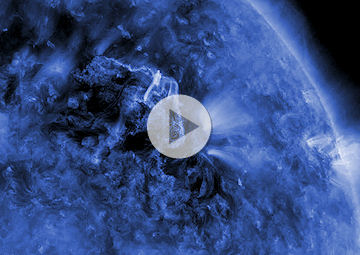NEW AND IMPROVED: Turn your iPhone or iPod Touch into a field-tested global satellite tracker. The Satellite Flybys app now works in all countries. | | | ASTROPHOTO-OP: Dwarf planet Ceres (formerly giant asteroid Ceres) is passing by the Lagoon Nebula in Sagittarius tonight. Both the nebula and the dwarf planet are easy targets for small backyard telescopes. Astrophotographers, point your optics here. Images: from Rob Kaufman of Bright, Victoria, Australia. NLC SEASON BEGINS: Recent data from NASA's AIM spacecraft show that noctilucent clouds (NLCs) are like a great "geophysical light bulb." They turn on every year in late spring, reaching almost full intensity over a period of no more than 5 to 10 days. News flash: The bulb is beginning to glow. Jesper Grønne photographed a bank of NLCs rippling over Silkeborg, Denmark, on June 1st: 
"I made a 3-hour movie of the phenomenon," says Grønne. "There was a lot of activity." Lars Zielke of Tvis, Denmark, witnessed the same display. "They were visible due north near the horizon. The clouds were not spectacular compared to others I've seen, but it's a start." There is a well-known correlation between noctilucent clouds and the solar cycle. NLC activity tends to peak during (and just after) years of solar minimum, possibly because low solar activity allows the upper atmosphere to cool, promoting the growth of ice crystals that make up the clouds. With the sun slowly emerging from a century-class minimum, the stage could be set for a good season of NLC watching. Typically, the first NLCs of spring are wan and pale, followed by better displays as summer unfolds. Browse the galleries from previous years to see what may be in the offing: 2009, 2008, 2007, 2006, 2005, 2004, 2003. MEMORIAL DAY FIREWORKS: On May 31st, around 2100 UT, a magnetic filament erupted on the sun. NASA's Solar Dynamics Observatory (SDO) recorded the action with 10-times HDTV resolution. Click on the image to play the movie--and be alert for "the twist!" 
Movie formats: 1 MB mpeg, 1.2 MB iPad, 0.5 MB iPhone
Magnetic filaments on the sun are a bit like rubber bands. They store energy when they are twisted. Take a rubber band from your desk and try it--twist, twist, twist. Eventually it will reach its fill and untwist explosively. That's more or less what happened on the sun. Play the movie again and note the untwisting motions near the center of the tempest. SDO's clear vision is revealing how these explosions work in unprecedented detail. Stay tuned for more.
May 2010 Aurora Gallery
[previous Mays: 2008, 2005, 2004, 2003, 2002] [aurora alerts] | 
